As a franchisor or franchisee, you understand how important marketing is for your business. However, with marketing happening on both sides of the franchise, there can a fair amount of confusion that results in marketing that cannibalizes itself.
Related: 4 keys to successful local marketing
There are many methods to handle franchise marketing. Sometimes, the franchisor and a corporate marketing team are wholly in charge. Other times, the franchisee takes on all marketing responsibilities. Most often, it’s a mix of the two.
It’s easy to see how this arrangement could cause confusion for your customers. But by coordinating your marketing efforts, your brand message will be strong and clear across all franchise locations.
Large-scale, national marketing campaigns
Here are some tips for coordinating large-scale marketing campaigns between the franchisor and franchisee.
Focus on the brand
In a franchise, the brand is often the selling point for customers. They know they can trust a certain brand and will support that franchise, no matter where they are. This is why it’s beneficial to focus on the overall brand image in your marketing efforts.
Provide a brand style guide
Franchisors can create a brand style guide for franchisees, to help them create on-brand materials and limit branding mistakes. It you aren’t sure how to create a brand style guide, take a look at this blog post for some killer examples.
Here at Lucidpress, we’re pretty obsessed with staying on-brand and empowering everyone (even franchise owners who have no design experience) to create visual content. If you’re curious how Lucidpress could streamline your franchise marketing, then check this out.
Communicate clearly & frequently
To maintain your brand image across multiple locations, communication is key. Set the precedent that there will be consistent communication regarding marketing efforts between the franchisor and franchise owners.
One area that’s often under-communicated is digital marketing strategy. The franchisor should coordinate website and social media creation with franchisees, so there aren’t multiple accounts that could confuse or misdirect customers.
Looking at these marketing strategies, the biggest factor is the brand. Build a strong brand identity that will give your franchises a good reputation, then give franchise owners the freedom to create their own marketing collateral using approved brand assets.
Small-scale, local marketing campaigns
Small-scale marketing strategies should focus on specific efforts in the local community. Franchises often have the good reputation of the larger brand, but localized marketing is what will win the community over and create a loyal fan-base.
By empowering franchisees to control their own marketing on a local level (and by giving them the tools to stay on-brand), individual franchise revenue will soar.
Here are more tips for localized, franchise-level marketing.
Find local sponsorships
Talk to local charities, sports teams or schools in the area to find opportunities to donate to a good cause and get some advertising. This is a great way to show community members that you’re invested in the area.
For example, when I was in high school, there was a Taco Time that always sponsored the school’s football and basketball teams. Their sponsorship included banners hanging up at the football field and inside the gym. They sold food at the concessions stand and had their logo printed on the game rosters. As you can imagine, my friends and I ate a lot of tacos.
This was a worthy investment for this franchisee, as it showed their support for the community and offered unique advertising opportunities. The owner of the Taco Time had a great relationship with the community and people loved going to his location.
Personalize your messages
When you’re advertising to a specific community, it’s important to personalize your messaging for your audience. Every community is different, and by catering to yours, customers will feel special and more inclined to support you.
A great example of marketing personalization is CrossFit gyms. Each gym (or “box,” in CrossFit lingo) has its own website and social media accounts that tailor their messages to the area where the gym is located. Whether it’s about the weather or events happening in the city, these gyms create a local identity for themselves that members can be part of.
Keep up-to-date
Encourage franchise owners to stay on top of trends and news as they create marketing for their franchises. Being in tune with the local news can help you spot opportunities and avoid embarrassing advertising mistakes.
Any time you post about current news or trends, make sure you do your research. An unfortunate example of this is DiGiorno. When the hashtags #whyistayed and #whyileft were trending on Twitter, DiGiorno tweeted “#whyistayed You had pizza.” The problem: these hashtags were dedicated to discussing and raising awareness of domestic abuse—an incredibly serious cause. Needless to say, many people were offended by the tweet and DiGiorno quickly apologized for its mistake.
Be where your audience is
This, of course, is one of the most important rules in marketing. No matter how clever and wonderful your marketing efforts are, if your audience doesn’t see them, then it’s a waste.
So, find out where your local audience is: Do they spend time on Facebook, Instagram or Twitter? Do they read the local newspaper? If so, that’s where you should be, too.
Be consistent with the brand
Much of the traction and business a franchise location enjoys comes from the brand name that it carries. To continue attracting and retaining that business, it’s important to stay true to the brand.
If the franchise brand is known for great customer service, then local managers have to make sure that customer service is a priority for them. Personalize each franchise to the local area, but stay true to the brand it represents. For example, maybe there’s a way to provide outstanding customer service that’s unique to your community.
A great example of this is Chick-fil-a. It’s a well-known fact that if you say “Thank you” to any Chick-fil-a employee, they will reply with “My pleasure.” Quality customer service is part of the Chick-fil-a brand, and customers can expect to receive the same level of customer service wherever they go. While each Chick-fil-a has its own concerted marketing efforts, they stay on-brand with their customer service.
Key takeaway
Marketing within a franchise can lead to miscommunication and overlap if the franchisor and franchisee do not coordinate their efforts. However, through communication and a good brand management system, your marketing efforts can complement one another and culminate in more success.
How can franchises maintain brand compliance across locations? Learn more in our free ebook, The complete guide to multi-location branding.
Small Business Saturday will be here before you know it, so we’ve put together a 5-step marketing guide that will help your small business brand knock it out of the park this year.
Related: 10 best social media campaigns you haven’t tried yet
1. Focus on a single goal
There’s a lot of hype around the biggest shopping weekend of the year. But that also means you have a lot of competition from retailers both online and off. To avoid burnout, it’s wise to pick one goal and stay laser-focused on it.
Of course, that doesn’t mean you can’t use multiple tactics to achieve this goal. Let’s say you own a beauty salon that relies heavily on referral business. Your goal may be to collect 200 referrals from existing customers. To make it happen, you’ll probably use a combination of email reminders, social media posts, and an in-store event. As long as every tactic points to your goal, you’re golden. Just be wary of offering competing promotions or asking for too much from your customers.
2. Take advantage of free design resources
American Express, the sponsor of Small Business Saturday, is offering several resources to participating small businesses. That includes downloadable templates for promotional material. These templates are good for showing your support of Small Business Saturday, but they don’t do a lot to promote your brand.
So we created a free template pack for you to customize with your branding for Small Business Saturday. All you need to do is sign up for Lucidpress (it’s free!), click the links below, then add your own logos and content.

Free digital templates (click to access)
- Banner ad (160 x 600) template
- Banner ad (300 x 25) template
- Banner ad (728 x 90) template
- Webpage header template
- Facebook cover photo template
- Facebook photo post template
- Twitter photo post template
- Digital or print flyer template
3. Look far and wide for ideas
Every industry has its quirks. So instead of telling you which ideas are best for your business, we’ll show you how to find them yourself.
- Check with your local government and Chamber of Commerce. Often these organizations already have a plan for Small Business Saturday that you can easily piggyback on. For example, the state of Utah is running a “Shift Your Spending” campaign to encourage residents to allocate 10% of their holiday spending dollars to local businesses. Chambers of Commerce are also known to give out Small Business Saturday collateral, like postcards and storefront signs.
* Ask your peers for winning ideas. Do you belong to a trade organization? Connect with members to see what they’ve done in the past. Head to relevant subreddits and ask whether other business owners in your field have promotional ideas for the big day. Check out small business forums like Manta and see what fellow SMBs are planning. You can even request membership to a few groups on LinkedIn and join the conversation there.
* Sell for a season, not just a day. Recognize that your Small Business Saturday efforts should be part of a larger strategy for the holiday season. Sometimes googling “Small Business Saturday” yields the same ideas over and over. To get some fresh ideas, try searching for holiday-related keywords, e.g. [Industry name + holiday marketing ideas]. And be sure to check out the Small Business Administration’s list of holiday marketing ideas.
4. Ramp up your customer service
The biggest shopping weekend of the year is also your biggest opportunity to get new customers and lock in repeat business. Creminelli Fine Meats is a local producer of delicious artisanal meats in Utah, and no stranger to the importance of customer service.
Creminelli’s CMO Jeff Fuller says, “I have found that Black Friday, Small Business Saturday, and Cyber Monday are all fantastic opportunities to attract new customers. The combination of social media, outdoor media, and buzz-worthy deals drives a huge boost in sales. The key is to have amazing customer service during that long weekend, so you can earn a repeat visit from those same consumers—and hopefully another purchase at full price.”
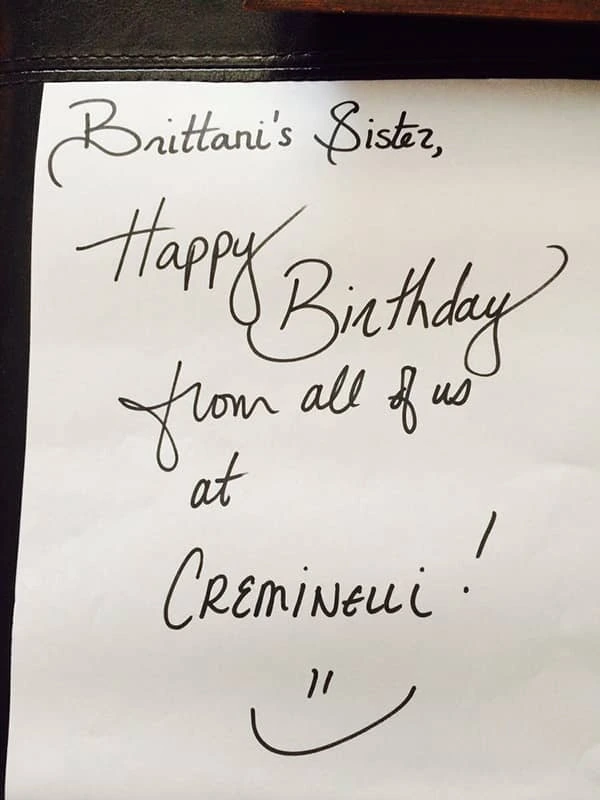
Make your customers happy with personal touches like this birthday note from Creminelli’s team.
Hiring additional staff can create a smoother shopping experience for your customers. What are other ways to delight them? Try using live chat to offer online shoppers the same great experience you’re creating in-store. Send thank-you cards to loyal customers before the big day. Hire a photographer, grab some seasonal props, and invite customers to snap their holiday photos while they shop.
There are tons of possibilities. Just think about what your customers will value most, then plan an initiative around it.
5. Don’t forget to follow through
You should have a simple way to gather contact info from customers on Small Business Saturday. This will build your mailing list so you can stay in touch year-round.
In all the hustle and bustle, make sure you engage on social media. Use the official Small Business Saturday hashtag #ShopSmall as you promote your business and chat with followers. Engaging on social media the day of an event is important, but more frequent posting is linked to higher engagement and loyalty from customers. We recommend amping up your posts both before and after Small Business Saturday.
And finally, it doesn’t hurt to offer discounts once the new year rolls around. This will help you stand out in customers’ minds from every other retailer.
Try Lucidpress today to create beautiful promotional materials for your brand—no expert knowledge required.
Here’s a startling fact for you: marketing has changed.
(Gasp!) I know. It’s a frightfully unsurprising tidbit of information. But here’s the deal—it’s not only marketing that’s changed, it’s who’s doing the marketing.
Gone are the days where marketing meant a highly-trained marketer doing mass marketing to a mass audience while everyone else focused on running a company worth marketing for.
Related: How to survive the democratization of content creation in 2018 and beyond
These days, “everyone else” is significantly more involved. Employees, partners, vendors (the list goes on) are often involved in creating content that represents your brand. And since marketing, when it comes down to it, is any touchpoint your brand has with its consumers, this sort of involvement can be frightening to brand managers.
From email onboarding to Yelp reviews to customer support, marketing has slowly crept up on every department and every employee to hold each and every one of them responsible for properly representing the brand.
The problem? Not everyone knows how to properly represent the brand.
As businesses expand across locations, consistent marketing becomes a major issue. Old logos are used, images are stretched, colors are off-hue, and horrific clip art is inserted into marketing collateral. It’s a brand manager’s nightmare. So how do we fix it?
Enter distributed marketing management.
Definition time!
Distributed marketing management is the process of creating, managing, and delivering marketing content across a wide range of channels and locations—all while staying consistent along the way. It’s the 21st-century marketers’ solution to allowing brands to easily expand without disrupting their messaging or their time.
Distributed marketing, whether you’ve heard of it or not, has become a common strategy among organizations for tackling their larger-than-life and never-ending list of marketing tasks. Up until the last decade, businesses lacked a way to centralize their ever-expanding marketing needs and get their brand out efficiently without disrupting it.
Plus, with a growing number of potential channels, audiences, partners, distribution methods (should I go on?), any normal organization quivers at the thought of dealing with all the moving parts on their own. They need something that helps them centralize, customize and manage everything without wasting time and without stepping on toes.
The benefits. Oh, the benefits.
This distributed marketing management stuff (try saying that five times fast) makes life a whole lot easier for marketers. A few reasons why:
- Cloud-based, lockable templates. Brand compliance is no longer optional (hallelujah). Brand managers can lock down fonts, colors, and images in their custom templates before employees edit them.
- Permission management. The balance between corporate control and local autonomy is secured by defining which employees can edit, comment, or simply view marketing content.
- Marketing asset management. Marketing assets are centralized, improving the efficiency of teams, ease-of-access to branded files, and overall brand compliance.
- Multi-channel distribution. The distribution of marketing materials, whether print or digital, across a variety of channels is extremely simplified.
- Streamlined workflow. The back and forth between corporate and local employees gets rather old. Distributed marketing software allows for real-time collaboration and gives local employees the ability to make changes without waiting for the help of a corporate designer.
- Saved time. By allowing employees to create and execute multi-channel marketing campaigns on their own, corporate marketers can use their time for the bigger projects and problems they were hired to tackle.
- Consistent branding. This one’s no secret, and (I think) has been sufficiently covered in this post. But, if it helps, consistent brands enjoy 3-4x more visibility than inconsistent ones. Yet another reason to make brand consistency a major priority in marketing strategy.
Distributed marketing in the real world
Heard of MHA? Most likely not. But there are thousands of elderly in Europe who have, thanks in part to distributed marketing.
MHA, the Methodist Housing Association, was founded during World War II with the goal of providing shelter and resources for the elderly. Now managing over 90 care homes and housing over 5,000 elderly, the association has spread across England, Wales, and Scotland.
The problem MHA faced was a problem common amongst such organizations. The various homes and communities operated mostly autonomously until very recently when the organization decided to attempt unifying the groups into a single entity. Up until this point, the communities had been self-run, using their own messaging, mediums, and marketing tactics for almost 70 years. MHA marketing knew they had to find something that was cloud-based and easily managed.
With just a little bit of research, Kwan Cheung, MHA’s Community Marketing Specialist, discovered that template-based marketing with Lucidpress would solve his inconsistency issues almost entirely. He updated MHA’s brand guidelines, applied them to some custom templates, locked down the branded elements, and distributed the templates to MHA’s various communities for them to localize without disrupting the essence of MHA’s branded style.
From branded posters and flyers, to Facebook ads and digital newsletters—MHA finally discovered a way to keep their brand consistent without slowing it down. Thanks, distributed marketing! (Read the full case study here.)
At the end of the day, marketing will always be hard. Once you get the messaging down, it’s hard to distribute it properly and quickly. That’s why implementing a system that helps you easily customize and distribute materials, no matter how big your business grows, is honestly worth every penny.
Convinced your organization could use the help of distributed marketing? Lucidpress includes all the above-mentioned features and more to help you centralize and manage your marketing campaigns. Give it a try and start working some marketing magic today.
Building a local brand is tough. Even if your business is in an area with significant foot traffic, developing your brand within the community is critical if you want to be successful in the long term.
Usually, when people talk about branding, they’re often referring to large companies with a proportional budget for their marketing strategies. However, brand building is essential for local businesses, too. It’s what will set you apart from your competitors and determine how your customers perceive you.
Luckily, to develop a local brand, you don’t have to break the bank. Here are five important tips to keep in mind for branding your small business.
Create local partnerships
Team up with other local brands, and make sure that your objectives align or complement each other.
If you’re unsure how to connect with other business owners, you can join local chambers or community service groups to expand your network, especially if you’re just starting out. Then, you can partner up for campaigns that promote each other’s brands.
Another way would be to reach out to local leaders of your community and help them where they are struggling. This gives your brand a social cause and shows that you value giving back to your community.
Simply put, building a trusted brand is much easier when you form connections locally.
Build relationships with the community
Small towns are all about building relationships and trust. If you show that you care about your customers—which you should, since public opinion of your brand can make or break your business—you’re more likely to earn their trust and, even better, their loyalty.
To make this happen, you should actively listen to their feedback, be responsive to messages and inquiries, tackle complaints as fast as possible, and resolve issues. All that is to say: provide excellent customer service.
Leverage social media
These days, if a brand does not have a social media presence, it may as well not even exist. It’s that important. Especially among millennials and the younger generation, social media is a must-have.
It’s also a great tool for promoting your brand to potential customers; let them get to know it, and show different aspects of it. Social media is one of the best ways to interact with your current customers.
You can use social media to show that your brand cares about its community by sharing any local news you think will be of interest to your audience.
Establish a local SEO presence
There’s no getting around it: SEO is one of the most important tools in a brand’s arsenal to generate new leads and develop awareness. Many of the searches people perform on their phones today are location-based—meaning they’re looking for businesses around them to meet their needs in that moment. Your brand should be right there in the search results, waiting to take care of them.
Investing in SEO can effectively build your online search presence and have a monumental ROI for your business. If you do it correctly, this can become a continuous source of new traffic and leads.
Some tips to optimize your website for local search:
- Claim your business page in Google My Business
- Verify your local address with Google
- Make sure your business’s name, address and phone number are consistent across all business directories
Control your online reputation
Online reviews are an important ranking factor in local search. Perhaps more importantly, they influence purchase decisions. Businesses with a low star rating or a low number of online reviews are ofen overlooked by customers. Reviews also provide a valuable source of feedback as the business identifies potential problems and improvements.
Tips for getting more online reviews:
- Send the invite before the customer leaves your business
- Make it ridiculously easy to request a review and to give a review
- Send review invitations via text
Give back
Giving back means different things for different people, but it all depends on what you can do for the community. For example, you can offer to mentor another business owner and show them the ropes, so to speak. Or, you can volunteer for a local program. Lucidpress has a team of volunteers that deliver Meals on Wheels each day to local seniors.
Another idea is sponsoring local events (e.g. farmers markets) or sports teams, which is an effective way of getting your brand exposed to many people in the same area—and building a positive perception of your brand.
Aside from the business benefits, doing good for the community is rewarding in its own way. It feels great to get out of your bubble and do something for others.
Be consistent
I love this quote from former Disney CEO, Michael Eisner:
A brand is a living entity—and it is enriched or undermined cumulatively over time, the product of a thousand small gestures.
Your brand is being shaped every day by the thousand small gestures your customers (or potential customers) are getting from your company. A gesture might be an interaction with one of your employees, a post on your company’s Facebook page, or even a direct mail piece you send out.
If all these things contribute to building your brand, it’s vital to be consistent with each gesture’s message.
So, these are some essential tips to keep in mind if you’re looking to build a local brand. If you follow this list of advice, you’ll be one step closer to making your brand a success.
How to have more consistent local branding:
Tip #1: Establish brand guidelines.
If you don’t yet have brand guidelines, create them. If you do have brand guidelines, revisit them and make sure they are up-to-date.
Tip #2: Make your brand guidelines easy to find.
The issue at most organizations is simply that their brand guidelines are too hard to find. The best brand guidelines are useless if they’re too difficult to find.
Tip #3: Pick the right brand champion.
I’m curious: how would you answer this question? Who in your organization has the PRIMARY responsibility to manage and protect how your brand is used? Initially, I would’ve thought that, for most organizations, the designer or senior creative person has the primary responsibility to manage and protect the company brand. I mean, they’re the ones doing all that “branding stuff” all day, right?
In our survey, CMOs/CEOs won far and away.
If brand consistency is important to your organization (which it should be), primary responsibility for managing and protecting the brand should fall to the CMO or another member of the executive team. When senior management recognizes the importance of managing the brand, it sends a clear message to everyone that the brand is worthy of protection and investment.
Know the differences between local audiences.
This is all about knowing your customers. Once you know your different customer segments, you can understand the differences between them.
For example, if you own a car dealership and have one location in a more affluent neighborhood than your other locations, you might notice that the affluent buyers are looking for something different than the buyers at your other locations. Maybe they want to see cars with leather and sunroofs. Your marketing at this location should highlight these things.
Some businesses naturally lend themselves to sharp design. Walk down any street in a hip neighborhood and you’ll see fashion boutiques, cafes and gastropubs displaying beautiful branding. Stylish typography, trendy color palettes—the kind of design that creates an enviable brand image.
Related: Building a local brand—5 essential things to know
When it comes to the service brands of the world—your plumbers, HVAC, pest control, any “man-in-a-van” type of business—design and branding are often an afterthought. The service comes first.
After all, there’s nothing cool about getting your drains snaked or having rat traps set up. Service brands don’t cater to a specific set of people the way a bar or boutique does. They sell a skill that everyone needs, not another form of self-expression. Beyond providing the best service possible, it’s hard to find ways to differentiate yourself from all the other service brands out there.
The result? Barebones websites, a lack of stand-out branding, and an endless supply of boring marketing materials. But it doesn’t have to be this way. In fact, investing in some simple branding & design can help your business stand out from the pack.
Why: The market is crowded
Service businesses, particularly in major urban areas, are incredibly competitive. A search for “plumber” on Yelp in Chicago will yield more than 2,000 results. In New York, that same search turns up over 6,000 results. Local plumbing businesses, nationwide franchise networks, and general service companies are all competing for the same work.
In a market that’s so incredibly competitive, you need a way to stand out from the crowd. When you ask a service brand what makes them unique, and how they’re different from competitors, you tend to get answers like “We’re really knowledgeable and honest with our customers.” Which is probably true. For them and just about everyone else.
That’s a great business model, but it doesn’t captivate the imagination. Before you can display your expertise, you have to get someone’s attention—and tradesmen, not being particularly design-focused, often overlook that the path to new revenue starts with awareness.
If your business has a bland website with sparse information, and you’re driving a white van in a city full of service vans, trucks and dispatch cars… how are you standing out? If you’re mailing brochures to potential clients, what saves that brochure from ending up in the trash?
In order to thrive in these competitive markets, you need to capture that initial attention. Marketing alone isn’t enough—you can drive visits to your website all day, and you can mail a flyer to every homeowner in town. On average, you have 8.25 seconds of their attention. Do you really think someone is going to look at a white-and-blue website that says “We’re trustworthy!” for more than 8 seconds?
Probably not. But then, how do you do it?
How: Color, design & user intent
So now, let’s welcome design back into the picture. We need it to capture the attention of potential customers, to stand out from the 2,000 other plumbing businesses in Chicago. But service brands don’t always have graphic designers—or even the budget to hire one. It’s tough to even know where to start.
Color
- A good starting point for service brands is color. Color has the power to influence user behavior. Often, service brands default to black & blues: simple, safe color choices that don’t stand out. That gives you an opportunity to choose something different.
* Color increases brand recognition by 80%. Some of the most notable service brands employ unique colors as part of their brand. Take Mosquito Joe as an example—the fastest-growing service franchise in the United States. Their bold green & yellow branding extends from their trucks to their uniforms. These eye-catching colors no doubt play a huge role in attracting new customers and franchisees.
Design
- Give your colors the chance to shine with some great design. Aim for a professional appearance, from the website to the trucks to the polo shirts your technicians wear. Every piece of your business should align with your branding to give your customers a consistent experience every time.
* This can sound like a daunting task to a non-designer, but it’s definitely achievable with the right tools. For example, Marq was designed with non-designers in mind, so anyone can quickly create attractive, on-brand content. You can create templates (or use pre-made ones) to publish and print- flyers
- brochures
- business cards
- newsletters
- banners
- social media graphics
- and much more.
User intent
- Finally, consider user intent. Who is your customer base, and what do they care about? What information do they need to make a purchase decision?
- Web accessibility: How easy is it to find the information they need on your website?
- Social proof: Do you provide ratings, testimonials, accreditations?
- Call-to-action: What can you say that persuades them to contact you?
When: Right now
It’s easy to put off projects like updating a website, improving flyers or repainting trucks. But, the sooner you can develop strong branding, the better off you’ll be down the road.
For many service businesses, winter represents downtime, which offers the perfect chance to brush up on your design skills and revamp your brand’s image. Imagine starting the next busy season with the right collateral in place to drive more sales. It’s within your grasp, and easier than you think.
See how Marq makes it easy to create attractive, professional marketing materials—no expert design skills required.
In a stressful world, it’s no wonder that people are drawn to the idea of “wellness.” According to The Global Wellness Institute, the wellness industry grew by 10% to $3.7 trillion between 2013 and 2015-while the global economy shrank by 3.6%. It’s one of the world’s fastest-growing industries, and as we move through 2018, it’s showing no signs of slowing down.
Related: 5 ways sleep can boost your productivity
For those in the wellness industry (and aspiring startups), this is both good and bad. Consumers are more aware than ever of the benefits of good sleep, a good diet and activities like yoga, and they’re seeking new ways to improve their health and productivity. Along with this increased awareness, however, comes the fact that wellness brands must fight for attention in an extremely competitive market.
Even a small glance at Instagram is enough to illuminate the ubiquity of food and fitness gurus. So how can you, in a market that’s perhaps best described as “visually noisy,” give your brand the best chance of standing out?
Determine your brand’s visual strategy and be consistent
We all understand the desire to get your brand out there, and it’s natural to want to jump straight into social media to put your brand in front of as many people as you can. However, there’s huge value in taking a deep breath and considering your content strategy.
The reality of modern marketing-much of which takes place in the digital realm-is that you have to create far more content than businesses had to in the past. For example, you might decide on:
- 3+ daily tweets
- 2 Facebook posts
- An Instagram photo
- An Instagram or Snapchat story
- A weekly blog
- Occasional guest blogs
That wouldn’t be an unusual workload, and it sits on top of all the ongoing work you’re already doing. Not only that, it needs to be compelling and engaging for your audience. Add to this your print marketing, website design, and everything else you have to consider, and you are looking at a huge amount of content.
It’s easy to see how you can lose consistency and quality control without careful planning and brand guidelines, which is where a platform like Lucidpress can help keep everyone aligned. Just ask brands like Bar Method and Club Pilates:
So where do you start?
Of course, defining your brand strategy is easier said than done. It helps to look at what else is out there. You’ll likely fall into a certain sector of wellness-like fitness, diet, alternative therapies or life coaching-each of which has its own norms that can be surprisingly hard to move away from.
Many fitness brands are overtly masculine with a palette of striking primary colors, photos of sweating brows and ripped abs, and a “no pain, no gain” mentality. Others take a gentler approach. Aspirational images of yoga performed in stunning landscapes is everywhere; you’ll often find it accompanied by encouraging language which values self-esteem and “finding yourself.”
Meditation tends to be pastel-shaded and broadly spiritual. Food brands are fresh-faced, brightly lit and often obsessed with avocados. None of this is bad, of course, and some elements may suit your brand perfectly. The trick is to incorporate inspiration from other brands while avoiding imitation and finding your own particular voice-and avoiding clichés as much as possible.
Don’t be afraid to show personality
One common theme in the wellness market is a tone of earnest sincerity. While it’s vital that you do sincerely believe in your product and its potential to improve the lives of others, one way to stand out from the crowd is not to let this fact prevent you from showing a little personality.
For example, try not to be too high-handed and “guru-y.” As an expert and leader in your field, your authority on these subjects should be clear. Being friendly, personable and letting some humor shine through won’t detract from this. Social media has changed the game for brands; being strictly professional is unlikely to catch anyone’s attention.
The visual language you use for your brand can be as fun, interactive and enjoyable as you want to set it apart from the dominant and blandly perfect images of “clean” living. Be public with your personality and enthusiasm for your brand and product.
Use science, don’t abuse it
One accusation often leveled at the wellness industry is the flippant and misguided use of scientific language in order to substantiate dubious claims. This can seem rather unfair, but unfortunately, a few high-profile cases have helped cement this view.
What’s especially unfortunate is that there’s so much legitimate science to back up the benefits of wellness practices. With a little effort, it’s easy to avoid the traps of bad science.
- When you hear scientific information from news articles, make sure to read the original studies. Journalists aren’t usually trained in scientific language and can sometimes misrepresent the findings. There have even been cases of journalists writing an article based on the work of another journalist.
* Recognize that different studies hold different weight. Look for the sample size, whether the methodology is well-supported and makes sense, and whether they were funded by organizations with vested interests.
* If some of your evidence is anecdotal, don’t be afraid to say so. Take the vegan diet as an example; it is demonstrably healthy in many ways and has both environmental and ethical merit. However, anyone trying to prove that it’s irrefutably the best diet for everyone is going to have a hard time, and they’ll likely spend their days arguing with others over opposing studies that suggest this isn’t true. If you have a great story to share, distinguishing between scientific study and what you believe through your own experiences is ultimately far more convincing.
Don’t maintain a social presence just because
It’s a near-fact of modern branding that you have to be on social media. However, a brand can get so busy that their social media presence becomes a half-hearted nod to the power of these platforms. This doesn’t mean you should shut down your branded accounts, though. It just means you have to think about them a little more.
The best place to start is to consider your own social media use. What motivates you to follow certain accounts? Why do you take the time to engage? If you look at your content and can’t find a reason why you would bother to like, comment or share it outside of your professional life, then it probably isn’t going to interest anyone in your target market, either.
Social media isn’t just a platform on which to post a series of promotions. A hard truth that every marketer has to swallow is that most people hate ads. What they do appreciate is being entertained, learning something new, or finding information relevant to them. With this in mind, before posting something to social media, consider whether:
- It will prove interesting to your audience. Is it funny, informative or entertaining? Is the imagery visually striking, beautiful or unexpected? Does it communicate your brand values?
* You actually find it interesting yourself. It’s important to notice when you’re posting “dead content” simply to fill up space or because you feel like you have to.
* You’re alternating promotional content with expert guides, behind-the-scenes insights, influencers’ content, and competitions. Your promotional content should be engaging in its own right.
The world of wellness is by no means oversaturated, and there’s much to be said for brands who want to provide people with tools and knowledge that will profoundly improve their lives. By finding your unique voice, your brand will naturally stand apart from the crowd.
See how Lucidpress’s cloud-based brand management software can streamline your creative process.
Building out a successful brand doesn’t hinge on offering a great product or service alone. You also need smooth, efficient operations that are consistent from location to location.
The most popular restaurant chains, for example, draw customers in everywhere because food quality and service quality are consistent across the board. People know what they are going to get and there’s comfort in that knowledge.
Related: 7 tips to coordinate local & national franchise marketing
Finding the best franchise management software tailored to the needs of your business is critical to its overall success. It will streamline day-to-day operations and keep everything from distribution to accounting running like a new high-powered engine.
Here’s a look at four examples of franchise management software designed to boost your brand.
Naranga
This versatile cloud and mobile platform is designed to streamline and automate both sales and operations. It’s used by more than 300 brands nationwide, and it handles a wide spectrum of needs for any franchise owner.

Naranga assists with key functions needed to run day-to-day operations. It can be used to train employees, streamline communications, onboard new franchisees, conduct mobile field audits, organize local marketing efforts, and turn leads into sales. (Phew, what a list!) It features tools like commissions manager to construction tracker to help franchise owners stay on top of daily operations in all franchise locations.
Marketing 360
Advertising is the lifeblood of any brand. You can’t get customers without getting the word out first. Marketing 360 makes marketing so much easier to manage, so you direct your time and money down the avenues that are most effective.
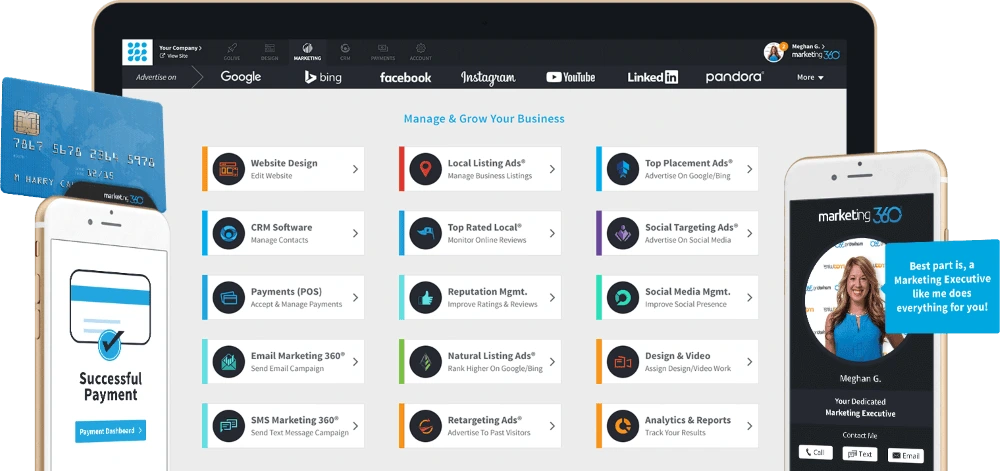
What sets Marketing 360 apart? It makes point-of-sale (POS) marketing a breeze. This platform features tools that track organic search results through keyword volume and ranking, analyze SEO performance for competitors through those same keywords, and segment and target ads to a specific demographic. Users can create branded webpages that include call-to-action buttons. The platform also makes it easy to customize and edit website templates.
Vonigo
This cloud-based platform sets the standard for service-based franchise software. It’s available with a monthly subscription that includes phone support and product tutorials. Vonigo offers an extensive customer management system that makes it easy to build client relationships and track all aspects of that relationship with built-in reporting tools.

With the platform’s tools, you can create invoices directly from work orders and route online payments to the destination bank account. It also includes automated route sheets for dispatching, a Google Maps interface for appointments, email notifications, and on-screen signature capture. Cloud-based modules from Vonigo handle multiple tasks including CRM, scheduling, online booking, work orders, invoicing, payments and reporting. All of it is accessible from desktop and mobile devices.
Marq
Branding is paramount for franchises. You want a consistent brand message that reflects the quality of the products or services your company offers. If you want to scale your design and keep it consistent, Marq has you covered with web-based, lockable marketing templates.

Marketing templates from Marq make it easy to localize your branding. Keep logos, fonts, images & colors all looking smooth, polished and professional. Its drag-and-drop editor makes it easy to combine images and text into eye-catching print and digital marketing materials.
Franchisees can customize and distribute pre-approved templates that prevent off-color or stretched logos. You can create, print and deliver direct mailers to multiple locations simultaneously with the Marq editor. A radial search function makes it easy to target prospects based on age, income, geographic location and other key demographic factors.
Key takeaway
Growing a franchise business is hard work, but it becomes much easier when you have the right tools in your toolbox. Give these four a try to see which one is the best franchise management software for your brand.
Get started with Marq, the brand management platform for franchises. It’s perfect for franchise brands of any size.
Turning your business into a franchise is an exciting process for you and future franchisees. An essential part of creating a franchise is drafting your franchise disclosure documents, often referred to as FDD. These documents help you determine whether your business should be turned into a franchise and how to plan the transformation.
Related: 7 tips to coordinate local & national franchise marketing
The FTC created this document in response to a number of complaints. In years past, salespeople would convince franchisees to invest in a franchise without all the necessary information. This caused many people to lose their investments.
Now, the FTC states that franchisors must give potential franchisees the FDD at least 14 days before any contracts are signed or any money is exchanged, so the franchisee can make an informed decision about their investment.
Franchise disclosure documents have a very specific format, divided into 23 sections that cover all the information a potential franchisee might need to make an informed decision and sign a contract.
FDD sections explained
Below are the 23 sections that are required for a Franchise Disclosure Document and a brief explanation of what each of those sections cover.
1. The franchisor and any parents, predecessors, and affiliates
This section covers the history of your franchise business, any parent company or companies that have come before the current franchise. This is also where you give an overview of your business model, the competition, and an offer to become a franchisee.
2. Business experience
Provide the backgrounds of key directors, officers, managers and employees who have played a large role in the sale and management of the franchise. This section is all about giving an introduction to the key players in the franchise and reviewing their past business experiences.
3. Litigation
In this section, discuss any past or current litigation your franchise has been involved in. This level of transparency is critical for earning your franchisees’ trust and making sure they’re well-informed.
4. Bankruptcy
Here, you discuss any bankruptcy that has occurred within the business. This includes not just bankruptcy that’s occurred within the company, but also to any of the key people involved in the franchise.
5. Initial fees
This is where you outline any of the deposits and fees the franchisee will have to pay in order to gain ownership and start up their own franchise within your business.
6. Other fees
Here, you outline the fees that will continue for as long as they own and operate the franchise. What ongoing royalties or yearly fees will you charge your franchisees for advertising, renewal of their ownership, or transfers? Make sure you provide a complete and accurate list.
7. Estimated initial investment
This section covers any costs the franchisee will incur to get the franchise up and running. This includes advertising, the cost of operations, and any other costs that may arise before the franchisee starts making revenue.
8. Restrictions on sources of products and services
This is where you include any restrictions you have regarding the sources and types of products and services offered through your franchise.
9. Franchisee’s obligations
In this section, you provide a clear reference to all the obligations the franchisee is agreeing to when they sign this contract.
10. Financing
Here, you describe any financing options or programs available through the franchise.
11. Franchisor’s assistance, advertising, computer systems, and training
This section details the obligations you have as a franchisor when you sign a contract with a franchisee. This section tends to be the longest, as it includes any assistance you offer before their business is open, as well as any ongoing assistance. In this section, you also outline any advertising assistance that will be provided for the franchisee.
Include information regarding any franchisee training programs offered through the franchise, as well as the support offered through the computer systems used throughout the business.
12. Territory
This section covers any territory offered to the franchisee and whether the territory will be changed because of this agreement. This section is going to vary greatly between different franchises, as each has its own philosophies regarding territory.
13. Trademarks
Here, you include information regarding your franchise’s trademarks.
14. Patents, copyrights, and proprietary information
Similar to the previous section, this section outlines information regarding the patents, copyrights and other information about how the franchisee can use these copyrighted materials.
15. Obligation to participate in the actual operation of the franchise business
In this section, you explain the personal obligations the franchisee will have in the actual operation of the business. These can vary greatly, so be specific.
16. Restrictions on what the franchisee may sell
This is where you outline any products or services the franchisee cannot offer from their franchise locations. These restrictions will determine what franchisees can or cannot offer at their location.
17. Renewal, termination, transfer, and dispute resolution
This section covers the costs or renewal, termination or transfer for franchisees. This is also where you cover how you and franchisees will handle disputes. These policies are critical to running a smooth franchise operation with as few disruptions as possible.
18. Public figures
If you use public figures (e.g. celebrities or public persons) for advertising or promotions, then state the amount they are paid here.
19. Financial performance representations
This section is where you provide information regarding the financial performance of other franchise units. According to Entrepreneur:
“The typical Item 19 disclosure consists of three types of information: 1) numerical presentations of revenue and/or expense data, 2) notes and explanations outlining the assumptions used in preparing these numerical presentations, and 3) disclaimers that carefully explain the limitations of the usefulness of the data presented.”
20. Outlets and franchisee information
This section lists information about all the other units within the franchise. This includes updated contact information for each unit, such as addresses and phone numbers.
21. Financial statements
This is where you include audited financial statements from the last three years.
22. Contracts
This is where you should put all the contracts the franchisee will be required to sign. Organizing your contracts this way makes it easier to find and reference them later.
23. Receipts
Franchisees are required to sign a receipt stating that they received the FDD. This protects your business and proves to the FTC that you did your due diligence. It will be placed at the end of the FDD.
Key takeaway
Your franchise disclosure documents are vital to maintaining your business’ health and your franchisees’ success. It’s important that you keep this document in order, up-to-date, and written in clear, concise language.
Your brand matters. If you’re ready to build your franchise brand into a consistent, compelling force that drives your business, this guide will show you how to get started.
Competition for customers is fiercer than ever, but a well-planned franchise marketing strategy can make you stand out from the crowd.
However, strategy is quite a complex subject. Can it be condensed into a simple article?
If you ask us, we say yes. We’ve distilled the most important steps a marketing strategy should contain. You’ll see in the examples below that even major brands follow the principles explained in this article.
Related: 4 best franchise softwares to boost your brand
Whether you’re a franchisor, a franchisee or a marketer, this is a great practical resource for you because every principle here is backed with concrete examples to inspire you.
Ready? Let’s dive right in.
Segment your audience if you want to maximize your results
You already know that you can have the best product on the planet, the most persuasive sales message, or the most creative ad ever—but if you deliver it to the wrong person, it will never work, right?
This applies whether you’re a franchisor looking for franchise buyers or a franchisee who wants to attract more people to your business.
So, if you want to make the most of your marketing efforts, your marketing plans have to start with your core audience in mind.
Below, you can find a few essential questions to ask yourself (or even better, your existing customers) to find out who’s most likely to buy from you.
Questions to ask yourself & your team:
- What are your product/service’s best features, and how does each translate into a benefit for the consumer?
- What’s special about your product/service in comparison to your competition? Are you unique, cheaper, quicker, better value, safer? The most trusted, the first, the oldest, the most tested?
- What could be your customer’s main objections?
- Which topics are your customers interested in? Who influences your ideal client (books, publications, media, influencers, etc.)?
- Where can you catch your ideal customer’s attention? Phone, email, social media, TV?
- What is your ideal buyer’s income?
Questions to ask your existing customers:
- Why did you choose us and not a competitor? Is there anything that pushed you in favor of us?
- How did you find our website or location?
- How would you feel if you could no longer use us? What would you miss?
- What’s one thing you don’t like about a competitor, or that we could improve to better meet your needs?
- What would you likely use as an alternative if we were no longer available?
- Have you recommended us to anyone? Why or why not?
Prioritize channels
One of the biggest mistakes entrepreneurs make is trying to be on every platform out there.
Trying to tackle every channel available can be a great strategy if:
- You have the resources to do this (time + money + knowledge).
- Your audience is on every platform.
The first point is pretty clear. Few companies have the resources to go that broad with their marketing efforts. Second, often times, our audience isn’t everywhere.
For example, if your target audience is between 18 to 25 years old, you might be better off going for Instagram than Facebook.
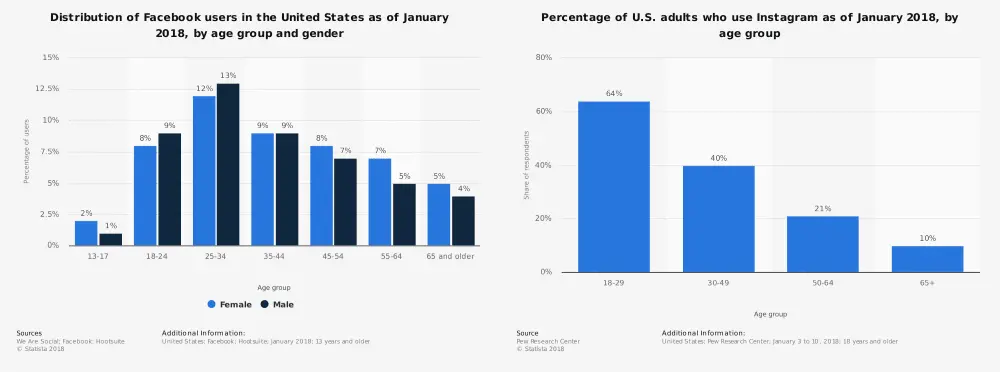
Source: Statista
Or, if you want to use Twitter as one of your main marketing channels in Europe, you might reconsider because Twitter hasn’t penetrated Europe as much.
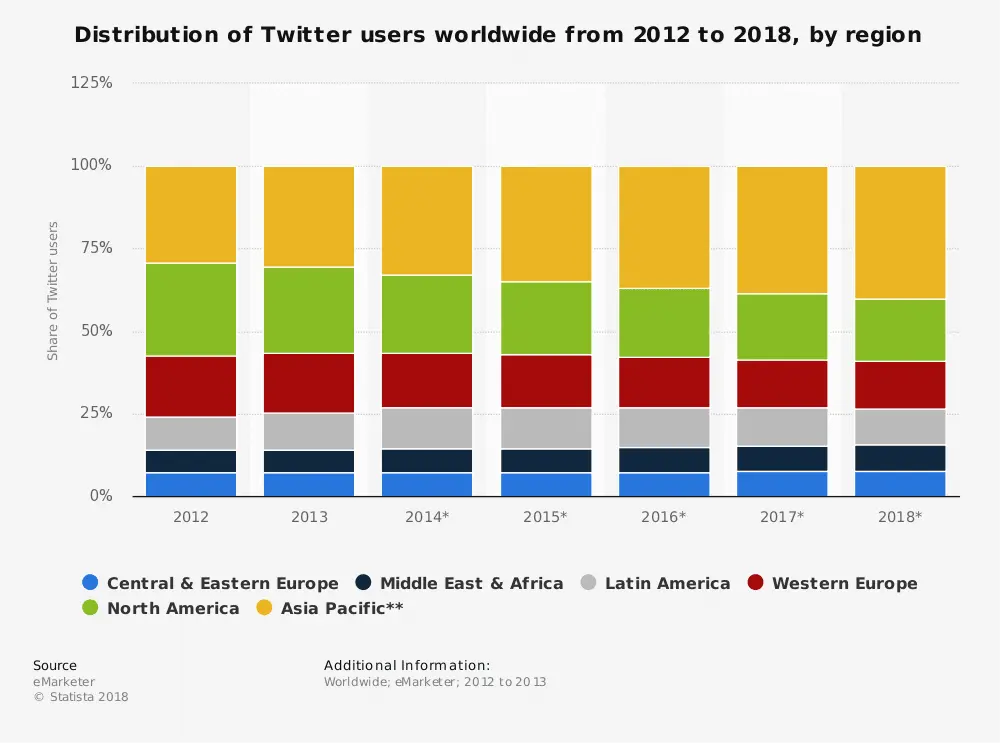
There are a lot of effective channels available. How do you prioritize them?
Here’s a simple, tested system borrowed from growth hacking marketing you can use. This is the same marketing concept used by startups like Facebook, Twitter, LinkedIn & Airbnb:

Source: GrowthHackers
Cost — how much you expect to spend on that particular channel (check cost statistics beforehand).
Targeting — how easy it is to reach your intended audience and how specific you can be. Does your chosen platform/channel have local advertising capabilities, for example?
Control — how much control you have once you go live. Can you stop it easily or adjust if it’s not going well? For example, it’s much harder to change a billboard than a Facebook ad.
Input time — how much time it will take to launch the experiment. Filming a television ad, for example, has a much longer input time than setting up a promoted tweet.
Output time — how long it will take to get results once it’s live. For example, search engine optimization (SEO) could be a great channel for your franchise marketing, but it has a much longer output time than pay-per-click does.
Scale — how large an audience you can reach with the experiment. Television offers much larger scale than advertising on a niche blog does.
Make sure you maintain consistent branding
Different channels require different creative.
Twitter is more text-based because people use it for news and articles.
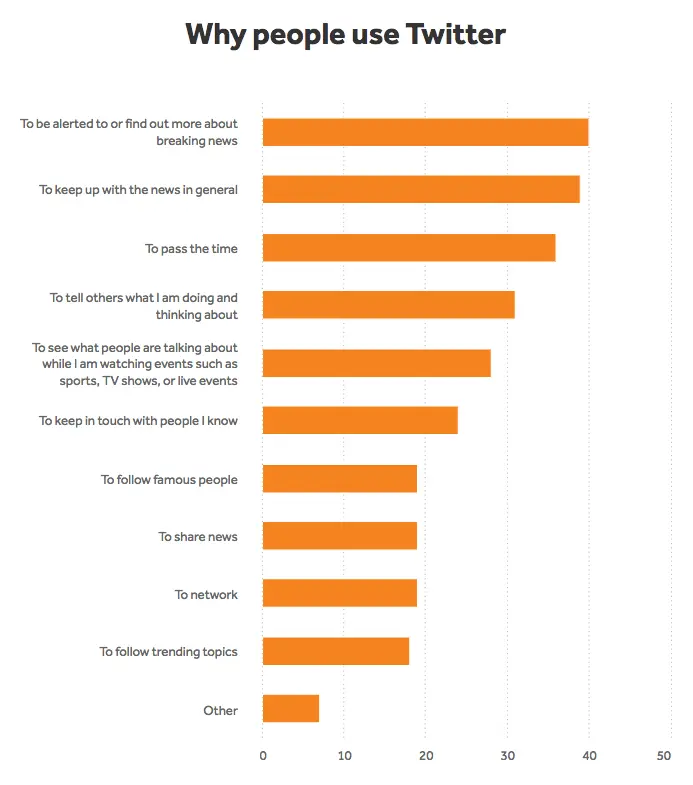
Source: Buffer
Instagram is a more visual platform and requires high-resolution photos.
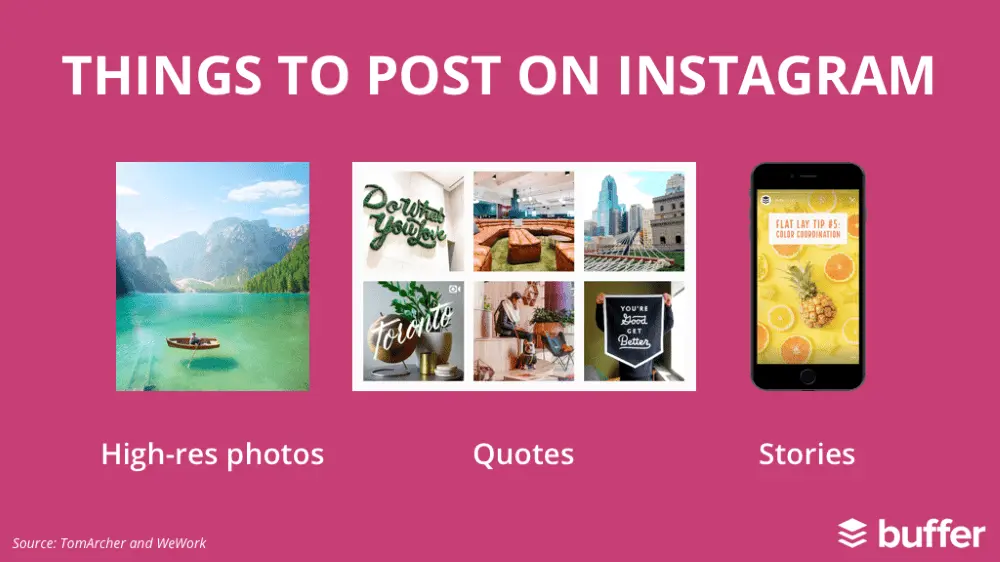
Source: Buffer
On Facebook, a recent BuzzSumo analysis found that videos have higher average engagement than images and links.

Source: Buffer
Therefore, no matter if you are a franchisor or a franchisee, you have to make sure you:
- Maintain consistent branding across all your franchises (as a franchisor).
- Maintain consistent branding across all your channels (as a franchisee).
What does this congruent brand identity actually mean? Below, you’ll find some real examples.
Communicate your value proposition in the same way across all channels—offline, online, TV, radio, direct mail or anything else. []
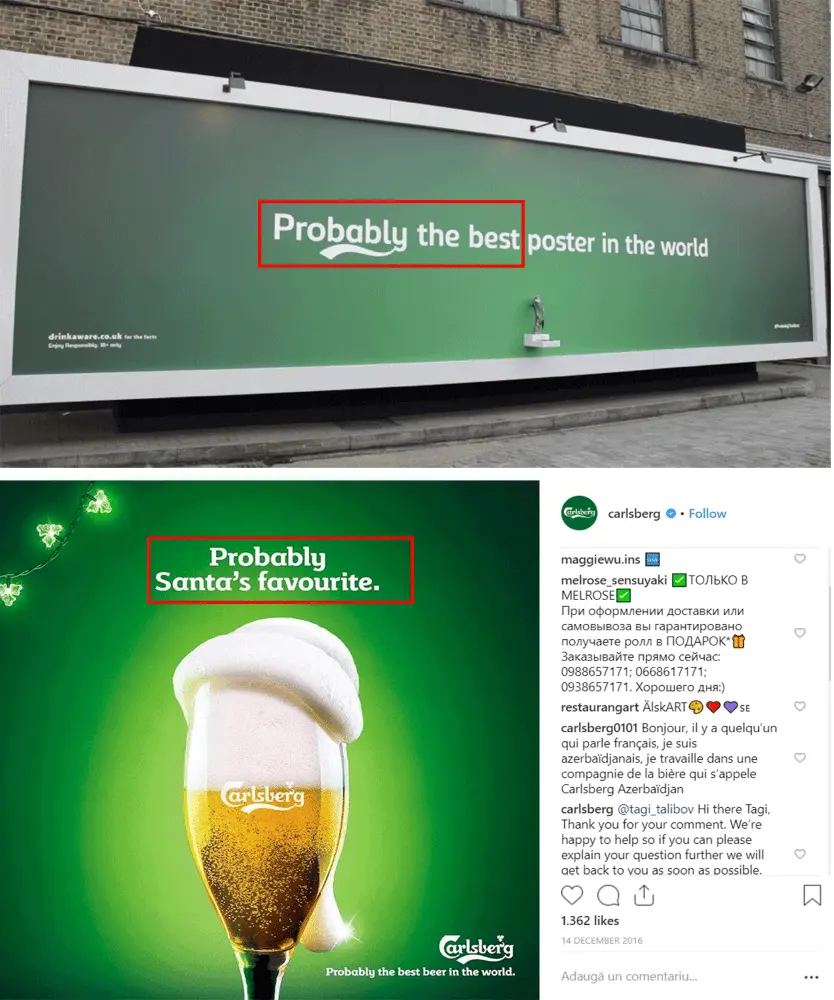
Your design (colors, logos, fonts, tone) has to be the same whether someone sees an ad on Facebook or landed on your website from a Google ad.
One of the best examples here is Coca-Cola.
As you can see, the color red is always present in one way or another. They also use the same fonts and design elements.

Another important element to a congruent brand identity is tone of voice.
If we continue our Coca-Cola example, we can see that almost all their posts express happiness, joy, fun, or the feeling of enjoying a great moment with friends.
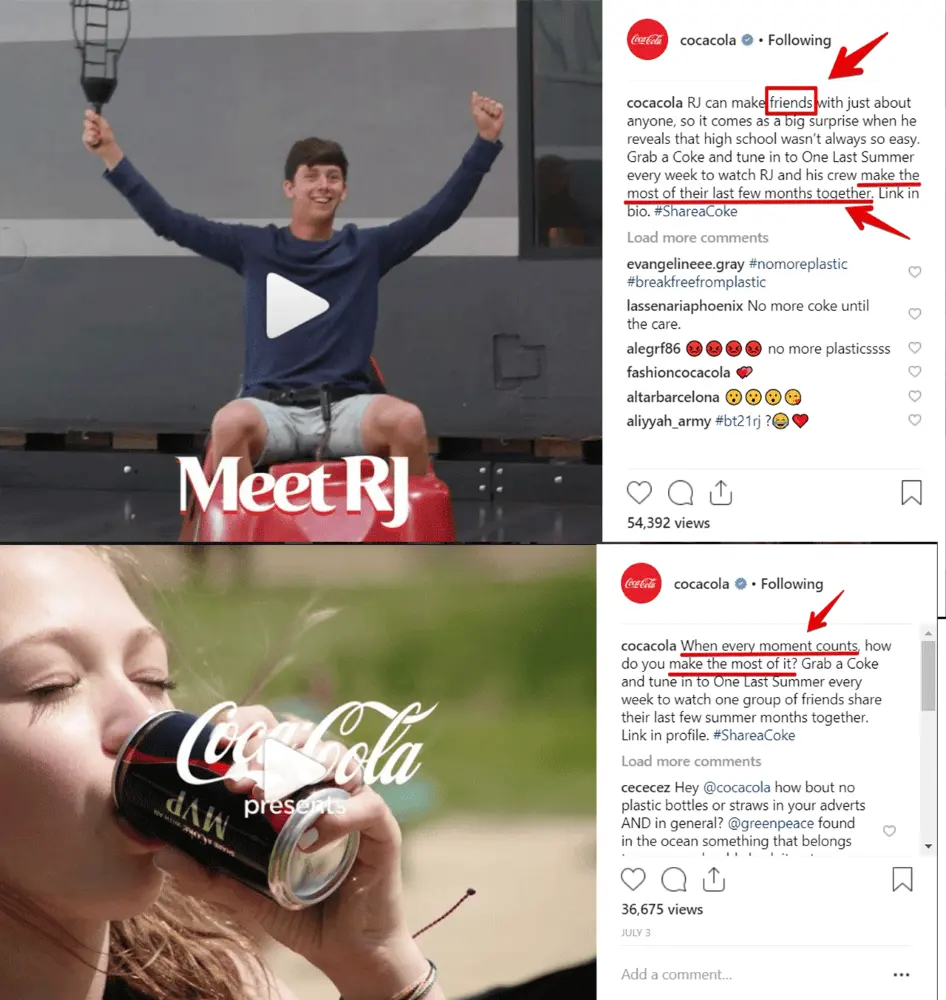
If we take another example, Charmin, you can see that whether they communicate offline or online, they maintain a playful tone.

How can you make sure your franchise brand stays consistent?
First, you’ll have to create a brand manual which includes details about your tone of voice, preferred professional terms, and general code of conduct. Every business should have one, no matter their stage in the journey to perfect branding.
(We’ve handpicked some of the best brand guideline examples for you.)
Then, in order to minimize errors, you can create “best practice” templates that are in line with your brand’s ethos and aesthetic.
This ensures no one in your company has to take matters into their own hands, because they can draw on templates that reflect your brand every time they create a new document.
If you’re using Marq, you can create & customize templates to easily create stunning content without having to start from scratch every time. And because of its innovative Brand Assets feature, you can make sure everyone is using the latest version of your branding elements. Fonts, colors and logos are all pre-loaded and ready to go.
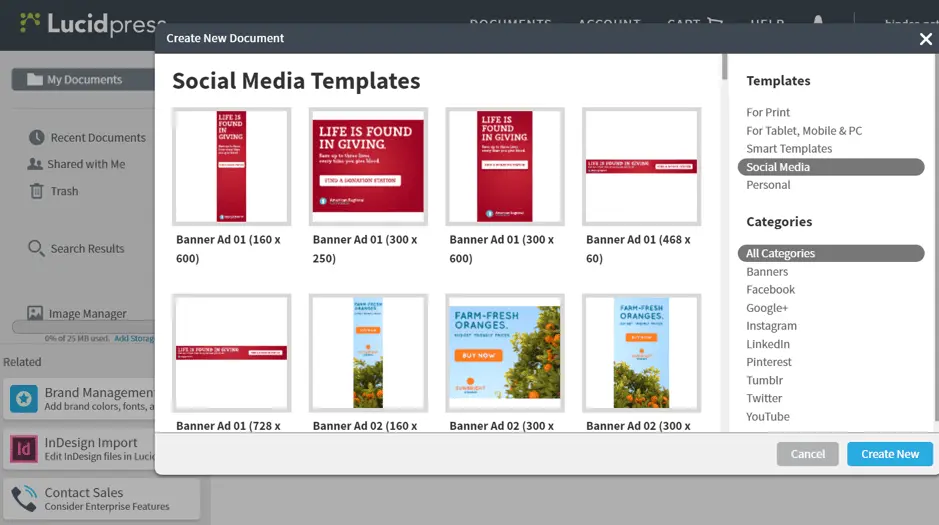
How can franchises maintain brand compliance across locations? Learn more in our free ebook, The complete guide to multi-location branding.

Before starting your efforts, make sure you can measure them
There’s an old adage that says half of the money invested in marketing is wasted. The problem is you don’t know which half.
Well, thanks to digital analytics, you can track your results so in-depth that you’d be amazed at how much leverage you have… if you measure the right things.
Here are just a couple of examples. Let’s say your marketing team developed two or three video messages for a certain audience, but you don’t know which one to choose.
It’s super easy. On Facebook, for example, you can check how much of your video was actually watched by a particular group.

If you compare it to television advertising, for example, you don’t get this level of accurate data. You can’t know whether a person left the room when the commercial started.
But, Facebook isn’t the only tool that allows you to track the results of your franchise advertising efforts.
If you run email marketing campaigns, you can see how many people opened your email and clicked on the offer inside.
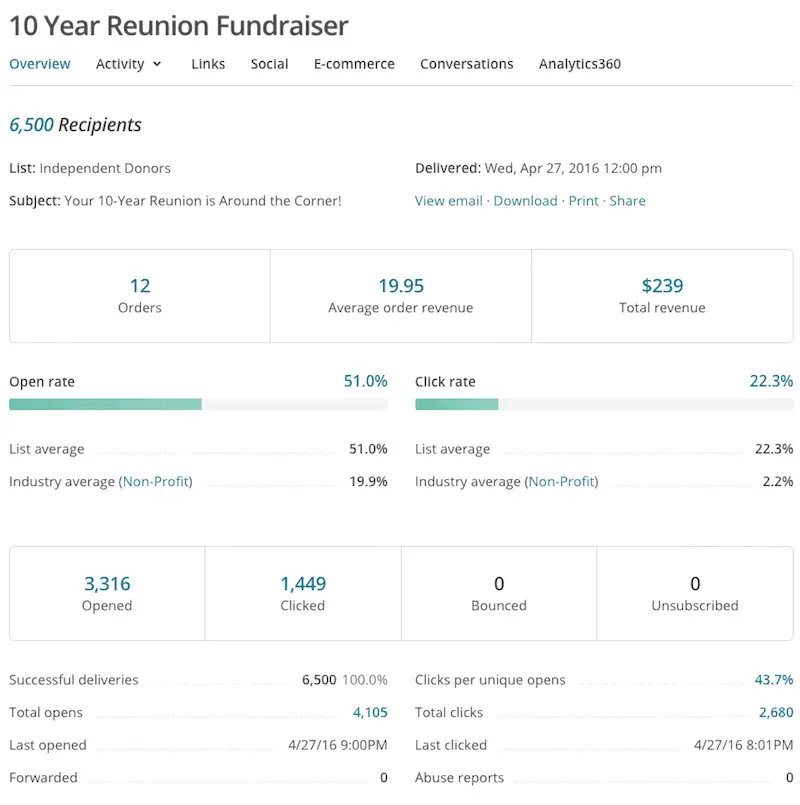
Source: MailChimp
If you run any other digital marketing campaigns, you can check Google Analytics to see how much time people spend on your website, which campaign brought in the best results, where the most traffic comes from, and much more.
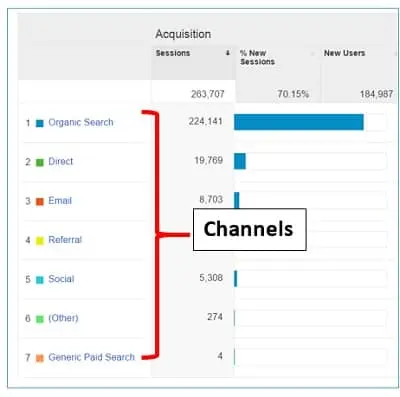
Source: Optimize Smart
Or, maybe you just bought a pizza franchise and you’re using local Google Ads. You can track how many times people called versus how much money you’ve invested and see if there’s a positive return on investment.
Ultimately, analytics don’t have to be limited to the online world. If you’re using offline marketing tactics like flyers or coupons, you can use codes to measure whether your campaign was a success.

Always keep an eye on trends
Marketing is first and foremost a battle for attention. If you don’t have people’s attention, you can’t communicate with them. If you can’t communicate, you can’t sell.
In the 50s, attention was on the newspapers, then on TV and radio.
Today, our attention is on social media. Messaging apps like Facebook Messenger are becoming more powerful.
Influencer marketing is growing, because they have people’s attention and they’ve already earned their trust.

Source: Google Trends
What’s next? Voice search & marketing will have a huge impact on consumer behavior. More than 35 million Americans used a voice-activated assistant at least once a month in 2017, according to eMarketer.
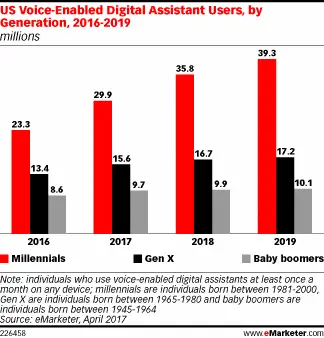
Coordinate local & national franchise marketing
There are many methods to handle franchise marketing. Sometimes, the franchisor and a corporate marketing team are wholly in charge. Other times, the franchisee takes on all marketing responsibilities. Most often, it’s a mix of the two.
It’s easy to see how this arrangement could cause confusion for your customers. But by coordinating your marketing efforts, your brand message will be strong and clear across all franchise locations.
Large-scale, national marketing campaigns
Here are some tips for coordinating large-scale marketing campaigns between the franchisor and franchisee.
Focus on the brand
In a franchise, the brand is often the selling point for customers. They know they can trust a certain brand and will support that franchise, no matter where they are. This is why it’s beneficial to focus on the overall brand image in your marketing efforts.
Provide a brand style guide
Franchisors can create a brand style guide for franchisees, to help them create on-brand materials and limit branding mistakes. It you aren’t sure how to create a brand style guide, take a look at this blog post for some killer examples.
Here at Marq, we’re pretty obsessed with staying on-brand and empowering everyone (even franchise owners who have no design experience) to create visual content. If you’re curious how Marq could streamline your franchise marketing, then check this out.
Communicate clearly & frequently
To maintain your brand image across multiple locations, communication is key. Set the precedent that there will be consistent communication regarding marketing efforts between the franchisor and franchise owners.
One area that’s often under-communicated is digital marketing strategy. The franchisor should coordinate website and social media creation with franchisees, so there aren’t multiple accounts that could confuse or misdirect customers.
Looking at these marketing strategies, the biggest factor is the brand. Build a strong brand identity that will give your franchises a good reputation, then give franchise owners the freedom to create their own marketing collateral using approved brand assets.
Small-scale, local marketing campaigns
Small-scale marketing strategies should focus on specific efforts in the local community. Franchises often have the good reputation of the larger brand, but localized marketing is what will win the community over and create a loyal fan-base.
By empowering franchisees to control their own marketing on a local level (and by giving them the tools to stay on-brand), individual franchise revenue will soar.
Here are more tips for localized, franchise-level marketing.
Find local sponsorships
Talk to local charities, sports teams or schools in the area to find opportunities to donate to a good cause and get some advertising. This is a great way to show community members that you’re invested in the area.
For example, when I was in high school, there was a Taco Time that always sponsored the school’s football and basketball teams. Their sponsorship included banners hanging up at the football field and inside the gym. They sold food at the concessions stand and had their logo printed on the game rosters. As you can imagine, my friends and I ate a lot of tacos.
This was a worthy investment for this franchisee, as it showed their support for the community and offered unique advertising opportunities. The owner of the Taco Time had a great relationship with the community and people loved going to his location.
Personalize your messages
When you’re advertising to a specific community, it’s important to personalize your messaging for your audience. Every community is different, and by catering to yours, customers will feel special and more inclined to support you.
A great example of marketing personalization is CrossFit gyms. Each gym (or “box,” in CrossFit lingo) has its own website and social media accounts that tailor their messages to the area where the gym is located. Whether it’s about the weather or events happening in the city, these gyms create a local identity for themselves that members can be part of.
Keep up-to-date
Encourage franchise owners to stay on top of trends and news as they create marketing for their franchises. Being in tune with the local news can help you spot opportunities and avoid embarrassing advertising mistakes.
Any time you post about current news or trends, make sure you do your research. An unfortunate example of this is DiGiorno. When the hashtags #whyistayed and #whyileft were trending on Twitter, DiGiorno tweeted “#whyistayed You had pizza.” The problem: these hashtags were dedicated to discussing and raising awareness of domestic abuse—an incredibly serious cause. Needless to say, many people were offended by the tweet and DiGiorno quickly apologized for its mistake.
Be where your audience is
This, of course, is one of the most important rules in marketing. No matter how clever and wonderful your marketing efforts are, if your audience doesn’t see them, then it’s a waste.
So, find out where your local audience is: Do they spend time on Facebook, Instagram or Twitter? Do they read the local newspaper? If so, that’s where you should be, too.
Be consistent with the brand
Much of the traction and business a franchise location enjoys comes from the brand name that it carries. To continue attracting and retaining that business, it’s important to stay true to the brand.
If the franchise brand is known for great customer service, then local managers have to make sure that customer service is a priority for them. Personalize each franchise to the local area, but stay true to the brand it represents. For example, maybe there’s a way to provide outstanding customer service that’s unique to your community.
A great example of this is Chick-fil-a. It’s a well-known fact that if you say “Thank you” to any Chick-fil-a employee, they will reply with “My pleasure.” Quality customer service is part of the Chick-fil-a brand, and customers can expect to receive the same level of customer service wherever they go. While each Chick-fil-a has its own concerted marketing efforts, they stay on-brand with their customer service.
Key takeaway
Marketing within a franchise can lead to miscommunication and overlap if the franchisor and franchisee do not coordinate their efforts. However, through communication and a good brand management system, your marketing efforts can complement one another and culminate in more success.
Before you start your franchise marketing strategy…
Everything starts with your ideal client in mind. From there, you decide which channels would bring you the best results, depending on your budget.
Next, you have to make sure your brand identity stays consistent across all channels—from your value proposition to your design elements.
Then, make sure you keep an eye on the latest trends in order to leverage first-mover advantages. This strategy will give your franchise business the best chance at standing out and finding success with your preferred customers.
Maintain brand consistency with Marq, the brand management platform for franchises. It’s perfect for franchise brands of any size.
It’s a big move, taking that first step to franchise the business you’ve built from the ground up. Now that you’ve done it and it’s paying off, what’s next? Are you ready to expand further?
Related: 4 best franchise softwares to boost your brand
Do you want to scale up your franchise system and present the opportunity to a wider audience? Build your real estate portfolio, increase sales, and hire more people?
In this post, we’ll introduce you to 8 key ideas you need to consider if franchise development is next on your to-do list.
In the first half of the post, we’ll look at developing your franchise system. In the second half, we’ll talk about marketing it.
Franchise development
1. Build a positive company culture
First things first: Are you doing enough to build a company culture you can be proud of?
Potential franchisees will be encouraged if they’re presented with a positive, supportive and productive culture.
When you first started out, that culture was right under your nose—but as you grow, it’s something you could easily lose touch with.
Work on your company values from the inside-out, listening to and learning from your people. Recognize that they’re your strongest asset, and welcome feedback and a collaborative approach.
When you’re open to new ideas, and you empower your employees to contribute, you’ll find that engagement and loyalty grows.
2. Take pride in your processes
You’ve already built a successful business, but as you continue to push forward with your franchise development plans, new problems will arise.
Tackle them head-on to find effective solutions, and communicate these changes clearly to your teams.
In today’s tech-driven landscape, efficient systems make all the difference. Demonstrate that you use the latest technology, and continually look for ways to improve your processes.
During presentations to potential investors or partners, highlight the technology and support you have available, and you’ll certainly make your franchise more appealing.
3. Prioritize brand management
Where you have existing franchises in place, take a tough stance on brand management.
Brand consistency is key here, as you’re trying to spread the message and demonstrate a strong, viable business that’s gaining traction.
Don’t foil your chances of further franchise development by neglecting the quality and unity of your current locations.
Brand management software that stores assets in the cloud makes it easy for a franchisor to develop a central system. A tool like Marq—with lockable templates and an easy-to-use editor—could solve your brand consistency problems overnight.
4. Get clear on your marketing strategy
It might sound obvious, but it’s worth saying: When potential partners can see that you’ve already been successful, they’ll be more likely to invest in franchise development.
Remember that one key benefit of taking on a franchise is that it comes with a ready-made brand and marketing assets that have been tried and tested.
Once you’ve found a marketing model that works, put plans in place for how you’ll scale it to bring in business for a new franchise.
Communicate those plans clearly, and you’ll reassure potential franchisees that risk is low—and chances of success are high.
Franchise marketing
Once you’ve tightened up your business internally, it’s time to get to work on your franchising marketing.
5. Create brand advocates
Have you brought your existing franchisees together to form a support network?
As much as it will help them learn more and grow in confidence, it could also prove a great way to attract new candidates.
If business is good and your teams are happy, existing franchisees will be more likely to sing your praises and support your franchise marketing efforts.
Focus on the people who are already in your circle, and they’ll be the ones to help you widen it.
6. Develop a strong web presence
To attract further interest in your franchise development, focus on building a solid presence online. It’s the first place candidates will look when they’re in the market for franchise opportunities, and it’s where they’ll go to check you out once they’ve discovered you.
A poor web presence could do serious harm to your reputation, and it’ll certainly dissuade interested candidates who might have plenty of other exciting opportunities in front of them.
Use your website to communicate your offer, then promote it on social media, in forums, on relevant industry websites or via targeted ads. Make sure the information you’re presenting is engaging, up-to-date, and geared towards your potential new franchisees.
As well as thinking about what potential candidates might be looking for, you might also want to include your own requirements and expectations. If the applicants you’re getting aren’t suitable, this is a clear sign that you need to switch up the message you’re sending out.
7. Research to find the most likely recruits
Do you know who your ideal franchisees are? Have you done your research to determine which type of candidate is best for your business?
Understanding the data surrounding different demographic groups might help you focus your search.
Did you know, for example, that nearly half of all millennials want to start a business within the next three years?
While this demographic may not readily come with the sort of cash injection you’re looking for, there are plenty of lending options available to them. With some clever research, you might be able to hook them up with the right opportunity.
8. Get noticed at industry events
To further the success of your franchising marketing, take advantage of industry events for reaching a niche audience.
By sponsoring events, trade shows and conferences, you’ll get your brand noticed by a select audience. Go one step further by attending these events and, aside from meeting potential clients, you’ll also make some worthwhile industry connections.
What you don’t need to do here is spend thousands to get seen. Find the right events, and the audience will be there waiting to hear from you.
Remember that people appreciate a transparent and professional approach much more than a hard sell.
Key takeaway
To increase the chances of success during your next round of franchise development:
- Get your house in order with a positive company culture, a strong business model, a consistent brand and a clear marketing strategy.
- Next, focus on your franchise marketing. Turn your teams into brand advocates, develop a strong web presence, target the right people, and get noticed at industry events.
If it seems like new Starbucks locations are popping up faster than weeds in your backyard, there’s a sound reason behind it. Successful franchises rapidly expand their reach because they begin with an effective business plan and focus on growth.
Related: Franchise development—what you need to know
Creating a business plan is the necessary first step for any business owners who want to bring a franchise into a new market. Well-crafted franchise business plans are the equivalent of an elevator pitch. Business owners can use them to convince others to invest the capital they need to hit the ground running. Lenders also require a business plan before they will sign off on any loans to a prospective franchise owner.
Creating your franchise business plan
A typical business plan includes four main sections. You can touch on these sections in an executive summary, then break down the details in each individual section. Each section functions like a signpost on the roadmap you’re drawing for your new business to reach its goals. Here’s an overview of those four sections and what they should include.
Business description
The purpose for this section is basically self-explanatory. It offers basic and essential information on the franchise itself. For example, it describes the products and services your business offers. You can also identify your customers and how your business will help them.
You should evaluate the market where you wish to set up shop and include information about it in this section. This includes an analysis of your direct competitors, identifiable challenges or risks that come with doing business in that market, and a breakdown of your target demographic. Discuss how you will approach and manage each of these factors within your business operations.
Management
Your business plan needs to detail your company’s management structure and any related core values or philosophies. Which positions will be responsible for managing day-to-day operations? Who will fill these positions? What qualifications and skills are required for each position? How will you hire and train the necessary personnel? What salaries and benefits will you offer to these employees?
Discuss the individuals who will be filling management and leadership roles on your team. Explain—in depth—what makes those particular individuals qualified to succeed in those roles. Franchising is only as successful as the management team doing the work behind the scenes, and the people reading your business plan will look over this section carefully.
Marketing
A new business can only succeed if it uses the right formula to reach potential customers and turn them into real customers. This is where your marketing plan comes into play. Your business plan should detail how you will reach customers and convince them to walk through your door.
Doing thorough market analysis is critical in this part of your overall planning. You need to identify your customers, assess their needs, and determine how your business will fulfill those needs. How will this data shape your pricing? What is your potential market share? Outline how you will market your business to reach that target demographic.
Financial projections
It takes a significant investment of capital to get any business off the ground, and franchises are no exception. Investors and lenders will be most concerned about turning a profit. They don’t want to sink funding into a business that will end up folding like a paper airplane at the first sign of trouble.
Your plan should outline a realistic budget that includes both startup costs and operating costs. These financial projections should cover your cash-on-hand, franchise purchasing fees, startup costs and operational costs. The budget should cover operational costs over a three- to six-month period.
Discuss how much capital you’ll need to cover these costs until your business turns a profit. You also need to demonstrate the accounting and inventory control systems your franchise will use. Include income statements, cash flow projections, and data sheets to project how your business will do once it opens its doors. Financial projections should be conservative and take into account as many variables as possible.
Getting to work
There are many great resources available to help you structure your business plan so that it conveys the message you intend with confidence. Franchise business plan templates can help you see what works best and how to put your vision into the right words. You can pick from assorted stock images, fonts, colors and other design elements to make it visually appealing and reflect your franchise’s brand voice.
If you’re not a professional designer, Lucidpress can help you start out on the right foot. We offer plenty of templates suited to meet your business document needs. Our intuitive online editor makes it easy to design traditional printed documents or embrace the virtual realm with interactive digital documents. Check out our template gallery for a dose of inspiration, then sign up for a free Lucidpress account to take one for a test drive.
Your brand matters. If you’re ready to build your franchise brand into a consistent, compelling force that drives your business, this guide will show you how to get started.
Running a business, in any capacity, takes hard work and perseverance. Specifically, though, for a franchise, there’s a whole different set of unique challenges for both franchisors and franchisees.
The primary challenge comes down to providing a consistent experience. It’s simple: A franchise must provide a consistent brand experience across each of its locations.
Related: Franchise development—what you need to know
What’s not so simple is ensuring that every part of operations is being done the same way. How can you ensure that brand messaging and logos are easily accessible and up-to-date, or that the service is as good as it should be at every single one of your locations?
This article should provide you with a start on how to achieve brand consistency in your franchise.
Make sure franchisees know the importance of reputation management
Let’s first discuss your online brand image. This directly affects how customers feel about your brand.
A positive reputation is something that’s hard to get back once it’s ruined. There are a variety of different platforms in which customers can communicate with other customers about your brand including Yelp, Google, and other forms of social media.
Chris Conner, president of Franchise Marketing Systems, advises, “Right from the initial training with the franchisee, the franchisor should be educating and informing franchisees how brand management and reputation management are important and part of their operational responsibilities in running the franchised business.”
Conner adds: “Once a franchisee is operating and running day-to-day, the franchisor should have regularly scheduled calls with franchisees where reputation management is part of that discussion and addressed in each interaction.”
“Franchisors who are able to grow their networks effectively typically have incredibly strong and consistent mechanisms in place to monitor, respond and execute brand management responsibilities,” he concludes.
Maintain digital consistency
In order to maintain consistency where franchisees communicate with customers online, you need a clear-cut digital marketing plan. The plan should include guidelines for how franchisees communicate via social media, blogs, emails and webpages. Make sure you provide franchisees with easy access to logos, font style, imagery & photos, brand tone and language.
Social media is an integral part of our daily lives. Each location should have a separate Facebook and Yelp page so customers can visit locations and leave reviews. Whether each location needs a separate Twitter, Snapchat, LinkedIn, Google+ or Instagram account is truly dependent on the brand.
Create a detailed social media policy answering questions like: What type of content should be posted—and what should not be posted? How should complaints and negative reviews be dealt with? You can streamline social media with a process to approve anything that goes out, create templates, or offer pre-approved content. That way, you don’t have to micromanage content for too many locations.
Let your franchisees know what your brand is
Franchisors need to feel confident about the brand before communicating what that brand is to franchisees. This encompasses everything from company-wide goals to how everyday operations are run.
Ask yourself the following questions, and once you’re confident in your responses, make sure your franchisees know it, too.
What is the brand?
Your brand includes the characteristics of your company that make it relatable to people. For example, popular sandwich franchise Subway is a casual, no-frills restaurant where customers can expect consistent, fast service with fresh ingredients.
What is the company’s mission? What are its values and goals?
Subway strives to serve fresh, delicious sandwiches that are made-to-order right in front of the customer. The team at Subway lists out three core values and principles on their website.
- “Always provide exceptional service to your valued guests.”
- “Provide the highest quality menu items at a price everyone can afford and enjoy.”
- “Keep operating costs low and ensure you have great systems in place and never stop improving.”
What story do you want to tell?
Subway offers healthy sandwiches at convenient locations around the world. Subway shows their customers that they have nutritional & community responsibility by “building stronger societies,” according to the company.
Who is buying your product or service? How do you market to them?
Today, it’s easier to understand who your customers are and what they’re looking for. According to customer identity company Signal, personalization is an important part of marketing for brands. When it comes to franchises, that means being able to speak to people in different markets on a personal level. For example, franchises can offer personalized online communication experiences (e.g. paid advertising, personalized emails, etc.).
Don’t forget the details
It might be obvious, but staying consistent in a franchise is about every little detail.
Gary Findley, CEO at Restoration1 and established franchise sales expert, writes that consistency is the most important factor when it comes to business success.
He writes, “Balancing brand uniformity while respecting franchisee independence and regulating brand messages while effectively targeting local communities are two of the struggles that often arise.”
To help achieve this balance, there needs to be a consistent aesthetic, product & experience at each location.
- Aesthetics. From the color of paint on the wall to the uniform staff is wearing, there should be consistency to how a business looks and feels. If you walk into a Subway in the state of New York, chances are it’s going to look the same as in Colorado, Washington and anywhere else.
- Product. If people are seeking one of your locations, it’s because they crave that same product they know and love. People don’t go to Subway because they want a local sandwich. They go to Subway because they crave the taste they’re familiar with.
- Experience. Just as customers want the same product or service they can find at all of your locations, the same is true for the experience. Experience encompasses everything—the music playing in the background, the seating, how to place an order or make a purchase, and the behavior of the employees. Employees have to be trained consistently on daily operations, including how to interact with customers, how involved they are, and how to handle complaints. For example, if a few locations are taking too long to prepare food—and your brand is known for speed—that will be a problem for your customers.
- Marketing. Each franchise needs to be consistent with how they market and who they market to. Determining which types of marketing campaigns & advertising techniques work best for your brand is the first step in implementing consistent franchise marketing. This includes having specific brand guidelines for your franchise and what you want your franchise to look like.
Strengthen franchisor / franchisee communication
Determining how each franchisee should operate and what brand consistency looks like is only half the battle. The real challenge comes in longevity: making it last. To build long-lasting marketing and operations, use the following process.
- Set clear expectations. Whenever a new franchisee opens a location, hold a thorough training where franchisees gain an understanding of your expectations. Outline everything in a manual to reinforce the goals. This includes everything from hiring procedures to aesthetics.
- Illustrate why this is important. Don’t just leave instructions on how to do things, but be sure franchisees understand the reasoning behind it. Staying consistent is going to create customer loyalty, brand recognition, and ultimately, a more successful business. Explaining the benefits will encourage everyone to stay on target.
- Communicate regularly. Plan to talk as much as necessary to succeed. Offer positive feedback when you see a franchisee doing things right, and of course, provide constructive criticism and encouragement when things need to get back on track.
Key takeaway
It can be difficult for a franchisor to maintain consistency across marketing and operations within a franchise… while also targeting local customers in different communities. Don’t give up on making your franchise marketing consistent.
For the best results, make sure franchisees know the importance of reputation management. Stay consistent with messaging across digital platforms, educate franchisees about your brand, pay attention to the details, and keep the lines of communication open.